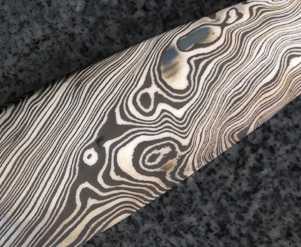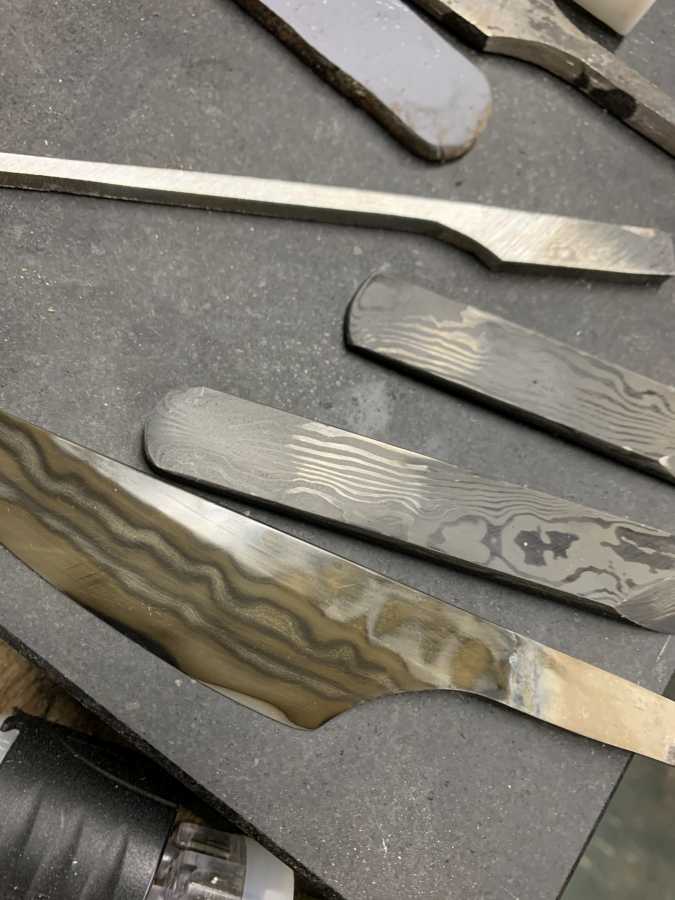Perhaps some of you know what’s going on with this; I’m mystified.
Most of the patina’ing (patination?) that knifemakers do is based on creating rust on a blade (Fe3O3) and controlling it so that the iron oxide turns to magnetite (Fe3O4). The magnetite is hard and fairly durable, and it’s a lovely dark color. Maybe there are some people in the world who swoon over the color of plain old rust, but not on a blade.
Parkerizing steel, and various other ‘bluing’ techniques has a huge history going way back – there are scads of techniques for bluing steel ranging from reactions involving copper oxide to straight up painting it with polyurethane and pigment.
The current thing, though, is soaking it in instant coffee. (or as we bladesmiths call it, ‘covfefe’) And, as skeptical as I originally was, it appears to work.

This is a blade I’ve been noodling with, and it’s polished up to about 800 grit. The blade is laminated wrought iron and 1095 high carbon steel. If you give it the ‘usual’ treatment by soaking it in ferric chloride, the acid attacks the wrought iron differently from the 1095, and that makes the weld pattern emerge. You can see what that etch does on the small spatula-like thing at the bottom of the picture.
 Usually, a soak in dilute ferrous chloride makes the pattern pop out in about 5-10 minutes. The current state of knife-making is to use steel that is close to ‘stainless’ like 15N20 that has a lot of nickel in it and resists the chloride fairly well, laminated with something that’s basically pure carbon steel (with some manganese) like 1095. I believe I understand what’s going on there is that the manganese in the 1095 reacts with the acid and produces a layer of Fe3O4. That makes the 1095 turn black(ish) and the 15N20 stays silver(y). The small picture is a piece from a work-in-progress, comprising of 200 layers of 1095 and 15N20 that were folded and twisted, and it was then soaked in ferric chloride and soaked overnight in Folgers instant coffee.
Usually, a soak in dilute ferrous chloride makes the pattern pop out in about 5-10 minutes. The current state of knife-making is to use steel that is close to ‘stainless’ like 15N20 that has a lot of nickel in it and resists the chloride fairly well, laminated with something that’s basically pure carbon steel (with some manganese) like 1095. I believe I understand what’s going on there is that the manganese in the 1095 reacts with the acid and produces a layer of Fe3O4. That makes the 1095 turn black(ish) and the 15N20 stays silver(y). The small picture is a piece from a work-in-progress, comprising of 200 layers of 1095 and 15N20 that were folded and twisted, and it was then soaked in ferric chloride and soaked overnight in Folgers instant coffee.
Roughly, it seems as though the coffee brings out the contrast so it’s about twice as contrasty as just the ferric chloride. So, I’m thinking there’s got to be something in the coffee that is staining the Fe3O4 magnetite darker. But, what? It’s permanent, too – or, at least, “fairly durable.”
This is what happens when the wrought iron/1095 knife is etched in ferric chloride and then spends the night soaking in Folgers:

The little kiridashi blades in the middle of the photo are 1095/15N20, and the lower one is wrought iron/1095. What’s weird about that is the way the 1095 (which comes out nearly black in the kiridashi knives) gets a brownish/lemony tone and the wrought iron stays bright(er).
I assume that there has to be some electrochemical thing going on here and that somehow the different reactions are being driven by ionization from the metal and impurities being dissolved. If you look at a blade with wrought iron in it, while it’s soaking in the ferric chloride, bubbles (hydrogen?) form on the bands of wrought iron – it’s apparently getting attacked/dissolved/converted more successfully than the 1095. “Who knows?” what’s in wrought iron. Back in those days it was slag and iron in a great big puddle and the slag was mostly consisting of various silicon oxides.
I’m mostly just rambling here – I don’t expect to ever fully understand what is going on in these reactions. But I feel as though someone who understands the physical chemistry (is this a job for P.Chem?) better ought to be able to look at a few of the popular knife steel formulations and think up some ways to process them that would affect them visually.
The other question I have is “what in the heck made some knife-maker think ‘maybe if I soak it in Folgers overnight?'” and actually try it.
Maybe urine…

Many discoveries throughout human history have been made completely by accident instead of by a directed plan. Perhaps that knife-maker needed something to stir his morning coffee, all he had was one of his blades, so he dipped it in and forgot about it, so it soaked for a while? Also, a question: would brewed coffee instead of instant work similarly, or is it just instant coffee that does the trick? Or is it, one should not waste brewed coffee on such a project except for ingesting it?
johnson catman@#1:
Also, a question: would brewed coffee instead of instant work similarly, or is it just instant coffee that does the trick? Or is it, one should not waste brewed coffee on such a project except for ingesting it?
I could brew some coffee I suppose.
@Marcus, I am a chemist, but not a specialist on this issue, however, my opinion is hopefully on the mark here:
The problematic rust on steel is not Fe2O3 but a porous mixture of various Iron hydroxides and carbonates. These chemicals are unstable and they act as a catalyst for further oxidation of the steel. They also are very porous and have a much bigger volume than the initial steel and thus they flake off etc.
When you boil said rust, you can convert it to haematite, actual Fe2O3, which is much more chemically stable and has lower volume and porosity. It is the simplest form of “bluing” steel.
To form magnetite, Fe3O4, various chemicals and usually also heat must be involved. The black that you get from treating the steel with cold FeCl3 is most likely a mixture of several oxides and it is not very stable or durable.
The black you get from coffee is most likely something akin to what you get when you treat steel with tannic acid -click-, i.e. the acidic tannins in the coffee form organic compounds with the iron in the steel.
If you have oak, fir or hickory bark available, you can grind it and test whether it works just as coffee does. I would bet my money that it does.
Charly@#3:
If you have oak, fir or hickory bark available, you can grind it and test whether it works just as coffee does. I would bet my money that it does.
Indeed I do have oak handy! And I have damascus blades. This calls for some science. I will experiment because, oddly, the answer is not in the bible.
Thanks for your explanation.
@Charly –
“parkerizing” is done using phosphoric acid and manganese dioxide, which are brewed together (does not appear to need specific amounts) with “a fair amount of phosphoric acid diluted in water” to “a pinch of manganese dioxide” – it produces a magnetite layer on the steel, which is a kind of matte grey-black that’s popular with the tactical set.
I’ve parkerized a few things and parkerizing a blade with wrought iron in it creates some interesting effects. Maybe I’ll polish that stabby thing down and parkerize it for the fun of it.
By the way, dear readers, the wrought iron/steel stabby thing was in the ‘fucked’ box because I accidentally got the 1095 edge layer on the wrong side of the blade, setting it up for a left-handed chisel grind. So, now I have a left-handed chisel ground stabby thing. I’m thinking I’ll finish it up eventually and post it for auction. Tentatively, I am calling it “Stabby O’Stabface from the County Stab.” Not sure what kind of mounting treatment to give it. I’ve been thinking of bolsters made of meteorite but holy crap is that stuff a pain to work with.
I can’t comment on the chemistry, but the effect is lovely.
I think an auction of Stabby O’Stabface is a great idea. I know 2 lefties who would find it appealing.
I can’t comment on the chemistry either, but the effect is indeed lovely.
Not much help here, but I remember receiving some advice to use new high carbon steel knives to do a bunch of fruit/vegetable cutting, as it would sorta hasten a patina developing. This was some time ago, so I can’t remember much else, but I think it was the various acids and such that were credited with speeding up the process.
Oh my.
Kinda-geochemist here – Charly’s explanation is pretty much bang on.
So, I brewed up some oak bark tea and soaked Stabby O’Stabface in it for 4 hours and it came out pretty much like the covfefe soak. I’ll do a post with pictures in a bit.
Yay, it worked. I hope there will be something interesting to see in the pictures. I hope to have the capacity and strength to make knives again soon. Unfortunately, right now I am all bound up with gardening.